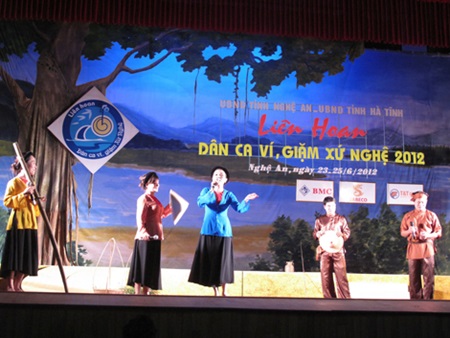Vietnamese folk songs get intangible cultural heritage status
 |
| Vi and Dam performance at the Folk Song Festival in 2012. – Photo baomoi.com |
The announcement was made last night at the ninth session of the Intergovernmental Committee for the Safeguarding of Intangible Cultural Heritage held in Paris.
In the central provinces of Nghe An and Ha Tinh, Vi and Dam songs are not accompanied by musical instruments. People sing them while working or doing activities such as cultivating rice, rowing boats or making conical hats, besides lulling children to sleep.
Speaking at the Paris session, Deputy Minister for culture, tourism and sports Dang Thi Bich Lien said that the recognition of Vi and Dam as cultural masterpieces of humanity is of great significance to Viet Nam as the songs play an important role in the local community.
 |
| Deputy Minister for culture, tourism and sports Dang Thi Bich Lien; Permanent Vice Chairman of the Ha Tinh provincial People's Committee Nguyen Thien and Vice Chairwoman of Nghe An provincial People's Committee Dinh Thi Le Thanh, attended at the session. |
Permanent Vice Chairman of the Ha Tinh provincial People's Committee Nguyen Thien and Vice Chairwoman of Nghe An provincial People's Committee Dinh Thi Le Thanh, who also attended at the session, said that they were proud of the recognition accorded by UNESCO to the folk songs of their localities.
They also acknowledged the responsibility for and the necessity of having specific measures to preserve the heritage, thus helping promote cultural identity and boost the sustainable development of the two provinces.
Vi and Dam are the ninth Vietnamese cultural practice to receive UNESCO's intangible heritage status.
The other eight practices are Hue's royal court music, Gong space culture in Tay Nguyen (Central Highlands) and love duets of the northern province of Bac Ninh, besides the Giong festival, Ca Tru ceremonial singing and Xoan singing, as well as Don Ca Tai Tu music and the worship of Hung Kings.
At the Paris session, 33 other cultural practices from across the world were also recognised by UNESCO as being intangible cultural heritage of humanity, raising the total number of elements in the list to 314.
What the stars mean:
★ Poor ★ ★ Promising ★★★ Good ★★★★ Very good ★★★★★ Exceptional
Latest News
More News
- Traditional Vietnamese crafts go digital to boost global reach (July 17, 2024 | 18:11)
- Standard Chartered Hanoi Heritage Race holds meet & greet (June 29, 2024 | 09:00)
- IFF Holdings, Marriott International open luxury hotel, residences (June 24, 2024 | 15:54)
- New Zealand Trade and Enterprise partners with major retailers to bring premium products to Vietnam (May 24, 2024 | 11:43)
- Vietnam’s tourism brand in need of methodical marketing strategies (May 17, 2024 | 07:52)
- Muong Thanh Group sets record for largest simultaneous Thai Xoe dance performances (May 08, 2024 | 11:42)
- Trang An marks 10th anniversary as UNESCO World Heritage Site (April 30, 2024 | 09:00)
- Visiting Trang An Heritage Region 2024 to join Trang An Festival (April 29, 2024 | 08:57)
- Le Méridien Saigon launches new series of Chefs' Table (April 15, 2024 | 15:35)
- Promoting Vietnam's tourism in Hollywood (April 13, 2024 | 08:00)

















 Mobile Version
Mobile Version